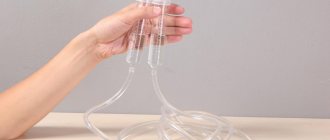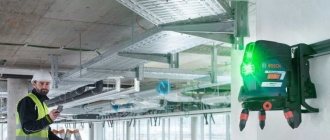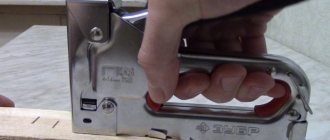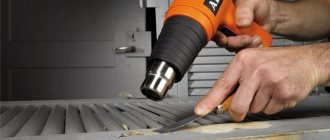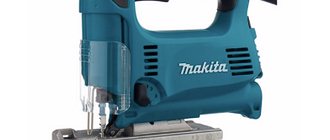The level is an indispensable tool when performing construction and installation work. It is necessary for the correct installation of doors, windows, laying bricks and tiles, checking the verticality of walls and horizontality of floors. With its help, modern household appliances and communications are installed.
The correct choice of measuring tool significantly improves the quality of work and saves time. By design, there are five main types of building levels: bubble, electronic, pipe, hydraulic, laser. Below we will look at each of them in more detail.
Classification of building levels
In total, you can find 5 types of levels that allow you to determine the necessary plane parameters (vertical and horizontal):
- Bubble (spirit levels);
- Electronic (digital);
- Pipe;
- Water (hydraulic levels);
- Laser (levels).
Each of the building levels has both advantages and disadvantages, that is, the scope of application and permissible measurement error. All the necessary parameters that you need to know are described in the technical documentation that is included with the purchase.
Device
A rigid monolithic, most often rectangular body with a milled bottom edge is made of light and durable materials (aluminum, polystyrene, plastic, wood) with an anti-corrosion coating. Depending on the required accuracy, a certain number of transparent sealed glass flasks (level eyes) with an air bubble floating in a colored alcohol-containing liquid are securely fixed in the body:
- one bulb - only for the horizontal guide (180 degrees);
- two - for horizontal (180 degrees) and vertical guides (90 degrees);
- three - for more complex work, with an additional third camera that controls the measurement of the angle of inclination (rigidly fixed at 45 degrees, or rotating - for measuring any angle of the controlled surface).
In order to minimize errors in angular vision, limiting lines—risks—are applied to the surface of the measuring flasks. Eyes for checking the position of surfaces of the vertical plane and the angle of inclination have built-in mirror reflectors for simultaneous monitoring of the position of bubbles.
Plastic plugs at the ends of the level protect the structure in case of accidental falls.
Some manufacturers of levels also provide additional conveniences: for example, a built-in magnifying lens for more comfortable control of the bubble, magnetic systems or fluorescent liquid flasks for the ability to continue work even in the dark.
The principle of operation of a bubble building level is simple: measuring and adjusting surfaces relative to the horizontal and vertical planes occurs by moving the bubble inside a certain eye of the level. The result of a correct setting will be that the bubble is located exactly in the middle between the measuring marks of the flask.
Spirit levels
Simplicity, accessibility, and versatility distinguish water levels from all others. Its design is simple: a flask (or 3) is placed in an aluminum or polystyrene body, which is partially filled with alcohol or other liquid. As a result, the air bubble shows horizontal-vertical.
Length from 300 mm. The larger the production, the longer it is needed. One of the types of spirit levels is magnetic, which allows you to work most effectively with metal structures.
Before you buy a water level, you need to know its advantages and disadvantages. The significant advantages include:
- Increased strength. Since some models have a cast body and special stiffeners.
- Suitable for any construction and installation work, regardless of the degree of complexity.
- Ideal for apartment renovation, even a beginner without qualifications can work with it.
- Low cost.
Among the disadvantages are:
- Not suitable for large-scale construction projects as its measurement accuracy is insufficient for this purpose.
- When targeting, you need to pay attention to the behavior of the bubble, correctly understand, and also interpret deviations.
- Do not throw it carelessly, as it can easily be damaged if dropped.
Application and design of levels
Various types of levels are used in all areas of activity where it is necessary to ensure the most accurate location relative to the horizontal or vertical of an object. First of all, this is construction, where levels are often used by carpenters, masons, finishers and other specialists to level the surface. This tool is no less in demand when assembling, repairing and installing equipment - installing machines, repairing cars at service stations, etc. A level is used both before installing equipment or laying material, and upon completion - to assess the quality of work.
The level design is quite simple. The working element is a hermetically sealed flask with measuring marks. The flask is filled with a liquid containing technical alcohol and an air bubble. The presence of alcohol makes it possible to work at low temperatures and reduces the viscosity of the liquid for faster bubble movement. In many models, luminescent dyes are added to the liquid for ease of work in the dark.
We list the most common types of levels:
- With one vertical eye - the most inexpensive option, not used for professional work.
- With a vertical and horizontal eye - allows you to determine the position of two surfaces at once.
- With three flasks. In the vertical and horizontal flasks, a peephole located at an angle of 45° is added. Allows you to determine compliance with a surface 45° from the horizontal.
Professional models are equipped with a large number of flasks duplicating the main scales for the most accurate measurements.
Electronic levels
The tool is additionally equipped with a protractor. Along with bubble chambers like in a spirit level, it has a digital display, sound indication, and, in some models, it is possible to record readings and detected slopes. The measurement accuracy is quite high (tends to 0.1⁰).
Requires calibration if the measurement accuracy exceeds the acceptable range of values.
Bubble device
The bubble level is familiar to anyone who has ever done a renovation or hung shelves on a wall. The device is distinguished by its simplicity of design. It is a rigid frame made of aluminum profile with intermediate ribs. To control the level, flasks are installed in it, where there is a small air bubble in the tinted liquid or alcohol. Based on its position relative to the graduated scale, the surface parameters are determined.
To check the level horizontally and vertically, flasks with the appropriate orientation are installed in the aluminum profile. A typical bubble-class device has another sealed tube with a small ball of air. It is located in a separate rotating block. Using a graduated scale, you can rotate it and set the angle value, the correctness of which the device will check.
There are different types of bubble levels.
- With one bulb, for monitoring horizontal or vertical surfaces. Such a mini bubble level can have the most compact dimensions.
- Double-cone.
- Three-cone, with a vertical, horizontal, rotating block to control different directions.
There is also a professional bubble level, which has 5 or more flasks. This tool was originally developed for laying engineering and plumbing communications.
Important! The arrangement of the device flasks forms angles that strictly comply with the requirements of SNiP and GOST regarding the rules for installing individual sections of pipe and other routes.
The round bubble level is also worth mentioning. This device is designed for testing small surfaces. Roughly speaking, showing the direction of roll, the round level makes it easy to adjust legs, equipment pads, and vinyl record players. It helps to correctly place devices for which the position in space affects the correct operation.
- the device is simple, no special skills are required to use it;
- the aluminum rail is durable and does not deform during storage;
- depending on the tasks at hand, you can select the most convenient dimensions of the device;
- the cost of the product is low.
- during different construction works it is impossible to use the same device with equal measurement accuracy;
- the product cannot be attached to a magnet;
- As the length of the level decreases, the error in measuring the inclination on extended surfaces increases.
Pipe level
When it becomes necessary to work with beams, pipes, as well as round profiles, which are important parts of structures, precise measurements are indispensable. First of all, the distinctive features of the pipe construction level are as follows:
- V-shaped body;
- Magnets;
- Flasks with liquid;
- Perforated tape;
- Attachment cord.
Among the disadvantages, one should highlight the narrow specialization - measuring readings of pipe laying and round profiles only horizontally.
Checking and adjusting the level
Level adjustment is possible only if there are non-fixed flasks in the instrument design. To check the level you need to:
- Place the tool on a flat horizontal surface.
- Determine the position of the bubble relative to the marks on the flask.
- Turn the tool horizontally 180°.
- Measure the bubble again.
At a healthy level, both indicators will be identical. If necessary (and if possible), the position of the flask is adjusted using special screws. During the adjustment process, it is necessary to alternately check the location of the bubbles relative to the marks in the manner described above until the indicators match.
Water level
It is also called hydrostatic. Designed to measure the horizontal of objects equidistant from each other. It consists of 2 flasks that are connected to each other by a transparent silicone tube 5 m long. First, before starting work, the system is filled 2/3 with liquid. When combining the flasks, look at the scale marked on their body and the readings should be the same.
Among the significant disadvantages are:
- Useless for apartment renovation;
- The large length does not allow it to be used in confined spaces
- Sensitive to temperature changes;
- When filling the vessels, you need to make sure that there are no air bubbles.
First of all, among the advantages we should highlight the low cost of the tool and relative ease of operation. Also, hydraulic levels are indispensable in large areas, since their cord reaches a length of 25 m.
Levels and rules: characteristics, types, types
- Bubble. The most common and well-known type of building levels: an elongated bar with a flask built into it - and most often several flasks (measuring capsules), each of which is responsible for its own measurement (horizontal, vertical, often a slope of 45°). Each flask contains a colored liquid and an air bubble clearly visible in this liquid; if the bubble is in the middle of the flask, between two lines marked on it, it means that the level is level and the surface corresponds to the required position. The most compact bubble levels are less than 10 cm in length, the most “large-caliber” ones are 3 m or more. — Goniometer. A device designed, as its name suggests, to measure angles between different elements. Usually consists of two halves connected by a rotary mount and capable of rotating relative to each other. To measure, these halves must be placed close to the sides of the angle being measured, so that the angle between them corresponds to the angle being measured. After this, the data can be taken either from a mechanical scale located directly on the rotary mount, or, in more advanced models, from a digital display. Many inclinometers are universal devices, supplemented with measuring capsules and can be used as bubble levels (see above).
— Inclinometer. An inclinometer, in essence... is a level with expanded functionality, capable of not only determining the very fact of deviation from the horizontal/vertical in a certain direction, but also measuring the specific angle of such deviation. Externally, such a tool is most often similar to the bubble level described above - even measuring capsules are usually included in the design. At the same time, electronic components are responsible for more advanced and accurate measurements, and a mandatory feature of a modern inclinometer is a digital display (see “Functions”). But instruments with rotating capsules (see ibid.) are not considered inclinometers; they are classified as ordinary bubble levels.
- Rule. In the classical sense, a rule (emphasis on “and”) is a tool in the form of a long lath, used in plastering and painting work to level various surfaces: plaster on walls, concrete mixture when screeding a floor, etc. In order for the rule to be used as a level, the design may include measuring capsules, as in a bubble instrument (see above). These tools have two key differences from a regular bubble level. Firstly, the rules in general are much longer - at least 100 cm, and often more. Secondly, such devices are designed primarily for leveling work, and horizontal/vertical/slope control is, in fact, an additional feature. Therefore, the functionality of the rules is noticeably more modest; they usually have only 2 capsules without any additional measuring instruments. And in some models there are even no capsules, and the use is limited to leveling. However, such “level-free” tools can also be useful in determining the horizontal/vertical: if the length of the existing level is not enough for effective measurement, you can put a long rule under it.
— Water (hydraulic level). A specific type of levels, the work of which is based on the law of communicating vessels. The design of the hydraulic level includes two vertical flasks, often with divisions, connected at the bottom by a long thin hose. Before use, the hydraulic level is filled with water so that it fills the hose and partially the flasks, after which each flask is placed vertically in the right place. The water level in communicating vessels is always the same - accordingly, the boundaries of the water in each flask will be at the same height from the ground. In this way, you can measure the relative position of two objects, make marks at the same height, etc. Moreover, the length of the hose even in the most modest models is usually at least 5 m, and in the longest ones - 20 m or more. This allows you to take measurements at distances that are inaccessible when working with conventional levels; and hydraulic levels differ favorably from laser levels in that the measuring points do not necessarily have to be in line of sight.
— Bubble (for door jambs). The bubble level for door jambs provides two meters at once: horizontal and vertical. This type of level is used to control the position of the support guides. The main feature of the models is their compact size, because the vast majority of such meters are created in the “mini” form factor - these are small and lightweight levels that are as easy as possible to transport. Bubble levels for door jambs have a very wide range of applications. They are used not only when installing door frames, but also when installing all kinds of pillars, columns, racks and other supporting structures that have a vertically elongated shape.
— Bubble (for area surfaces). The bubble level for area surfaces has a folding cross-shaped design. The crosswise legs of the level allow you to occupy as much area as possible on the surface being measured. Because of this, such levels are called “areal” (for areal surfaces). This type of level allows you to control the position of the surface in both horizontal and vertical planes. Bubble levels for area surfaces make it possible to easily and quickly “beat off” surfaces when installing various equipment, furniture and other interior elements. This level is convenient for monitoring the correct position of billiard tables, washing machines, refrigerators, etc. The folding design of the level makes it possible to easily store and safely transport the measuring device.
— Bubble (for racks). Bubble levels for racks are designed to control the installation of posts, columns, partitions and many other structures. The level for racks usually has a bubble indicator for both the vertical plane and the horizontal plane. The so-called corner levels have become widespread. Such devices consist of two faces connected by a movable hinge. The vertical level meter is located along the hinge, and on each of the faces there is a horizontal bubble meter. Almost all rack levels are equipped with a magnetic holder, which makes it easy and quick to fix the device on metal surfaces. If the level is used to control wooden or concrete structures, then in this case the tool should be secured with a tightening belt, elastic band or cord.
— Bubble (round). The round bubble level is designed to control the location of surfaces in the horizontal plane. Such meters have the shape of a compact hemisphere. The diameter of the average round bubble level is 4-5 cm, the weight is within 20 g. This type of meters has proven itself well when installing countertops, cabinets and other furniture, as well as household appliances. Tripods for mounting optical instruments (photo and video cameras, levels, telescopes, etc.) are often equipped with a round bubble level. Rounded advanced levels may use a degree inclination scale.
— Bubble (suspended). The bubble suspended level is designed for laying a horizontal beacon between surfaces located far from each other, which are connected by a cord (cable, thread, rope). With this level you can “beat off” the horizon when constructing walls, fences, borders and other objects. The bubble-type level body is equipped with hooks, with the help of which the meter is easily fixed on a pre-tensioned rope. Using a bubble level, you can control the position of a horizontal beacon between objects at a distance of 10 m or more. Of course, as the distance between extreme points increases, the accuracy of observing the horizon will decrease. This type of level is mainly used in those areas of construction where a high level of accuracy is not required from buildings. Suspended levels have proven themselves well in landscape design.
— Bubble (frame). Bubble frame levels allow you to control the parallelism and flatness of surfaces with precision accuracy. A good frame level makes it possible to identify surface unevenness with an accuracy of 0.01 mm per 1 meter. Frame levels are widely used when checking guides of metal-cutting machine tools. It is convenient to use a frame-type bubble level to control the evenness of the guides after they have been repaired by scraping, milling and grinding. Bubble frame levels are considered universal meters, because the frame structure has 4 sides. That is, this level can be trusted to control both horizontal and vertical surfaces. Additionally, one or more faces may have a prismatic shape, which makes it possible to place a level on a cylindrical surface, that is, on a shaft.
Laser building levels
Construction laser levels are a professional measuring tool. Since they provide the most accurate markings of all existing levels. However, the measurement error is affected by the class of the device. Divided into:
- Linear;
- Rotary;
- Manual;
- Automatic.
The range of work they perform is impressive:
- Surface leveling;
- Installation of attachments;
- Wallpapering;
- Ceiling installation;
- Tiling;
- Installation of partitions.
How to apply the level
When using a level, remember that the measurement is carried out using a working surface. There are models where all surfaces are treated equally, while others have a surface with a raw edge or magnetic inserts (convenient for installation on metal elements). The level cannot be placed sideways, as this will measure a non-existent surface.
Basic measurement rules:
- To determine compliance with the horizontal plane, firmly place the level on the surface being measured.
- The deviation is determined by the air bubble in the flask on the long side of the level. When deviating to the left, it is necessary to raise the right edge and/or lower the left one. In case of deviation to the right - vice versa.
- The vertical deviation is determined by the bulb in the narrow part of the level. To do this, the tool is applied with the container facing up and the movement of the bubble away from the wall indicates the presence of a convex unevenness. Moving towards the wall means the need to increase the volume below the level.
What is the most accurate building level
It is worth noting that the list where you can use a construction laser level is far from complete. The tool can be used for any repair, construction and installation work.
Its significant drawback is its high price. But if this doesn’t scare you, then this is the best choice, preferred by professionals.
The variety of functions can also confuse an inexperienced beginner. But if you figure everything out, the laser level will become a reliable friend that you can completely rely on!
Hydraulic levels and their characteristics
To check the slope of long surfaces, use a water level. The two test tubes are connected by a long flexible hose. The hose length can be from 5 to 25 meters. They fill with water. The device works on a physical principle where atmospheric pressure equalizes the column of liquid in vessels. If the water column in the vessels is at the same height, then the goal has been achieved. Compared to other levels, it is the cheapest. Also, when purchasing, you should pay attention to the quality of the materials from which it is made. The capabilities of this tool are limited, which is its disadvantage.
Manufacturers
It is important to choose a quality tool, and in order not to study the list of manufacturers for a long time, it is enough to focus on the most famous ones that have proven themselves well in the market:
- Stabila Germany);
- Kapro (Israel);
- Stanley USA);
- Sola (Austria);
- Bosch (Germany);
- Condtrol (Russia).
By trusting reliable manufacturers, you can be sure, for example, that you won’t run into a Chinese counterfeit and won’t waste your money.
What factors to pay attention to when choosing a level
When choosing a building level, you need to analyze several significant factors so that the tool does not turn out to be a useless purchase. So, to choose a measuring device, you need to consider:
- Device type. For example, to perform a single repair at home, a standard bubble level is sufficient; for convenience, you can also use an electronic one, which will notify you at the right time that the correct result has been achieved. When constructing a metal frame, it is better to give preference to a magnetic device, but in the case of constructing a foundation and building a house, you should acquire a laser device.
- Length. Here everything also depends on what needs the device will be used for. For example, a 50-60 cm level will be enough to hang cabinets and correctly install any other furniture. A longer option will be required for brick or stone masonry, when it is necessary to control each laid row.
- Placement of measuring lines. Usually on capsules with bubbles, all the risks are depicted on the outside. This option is not very convenient, since such markings can quickly be erased. If it is located from the inside, then it will last many times longer.
- Workmanship. Each flask that is present at the construction level must be perfectly transparent. In addition, it is important that the housing structure is durable, since the instrument will fall repeatedly during operation. Moreover, you need to look at the reliability of fixing the bubble containers. If the design of the level does not seem reliable in appearance, then it is better to refuse such a purchase.
In general, when choosing a building level, you should give preference to trusted manufacturers, and in order not to get confused by them, we suggest that you familiarize yourself with the next section.
Construction level of short length Source nazya.com
How to choose a building level: basic criteria
First of all, when purchasing, you need to decide what requirements the tool must meet. For example, make approximately the following list of criteria, which will greatly simplify the selection of the appropriate level for the tasks:
- The scale of the work performed, as well as the complexity;
- What special construction skills do you have;
- What functionality and usefulness is expected from the tool;
- Cost and manufacturer.
First of all, before choosing a building level and buying it, the device must be checked for functionality. As a result, the purchased tool will last a long time and will be a faithful assistant throughout the entire length of repair and construction work.
How to set up a bubble level
Typically, devices that use unfixed containers need adjustment. To make the adjustment you will need to do the following:
- First, you need to choose a wall in the room with the most flat surface, then an area on it to check, which should be located at eye level, and the corner should certainly be on the left side.
- Now you need to measure a distance of 4 cm from the corner. In this place you need to drive a nail or tighten a self-tapping screw. But keep in mind that the fasteners should not go in all the way - 2-3 cm should remain on the surface.
- Now you need to take the device, place one side of it on a nail and lean it against the wall. Now they begin to adjust it so that the air in the container shows a flat surface. Next, focusing on the edge of the level, a line is drawn on the wall.
- After this, the device must be turned over, and then the same steps must be performed again.
Without a building level, today it is impossible to carry out almost any repair or construction work. Therefore, not only a professional builder, but also any home craftsman should have such a tool.
The bubble building level provides fairly accurate readings, however, to be sure of its high-quality work, you need to know how to choose it. Purchasing a branded product does not guarantee that the building level will work without failure.
Since the bubble building level contains rather fragile elements, it is necessary to inspect them for damage . And, of course, you need to make sure in the store that the device is in working condition. Otherwise it will be of no use to you.
Laser devices
The laser building level shows maximum measurement accuracy, from 0.1 to 1 mm per meter of surface. The device generates a thin laser beam. Devices with different functionality are produced. Some work with one emitter to control the vertical or horizontal plane. Others operate with three lasers to measure parameters of floors, walls, and surfaces at an angle. Still others are able to construct planes using rotary heads for visual modeling.
- highest accuracy;
- can be used both indoors and outdoors;
- small dimensions and weight;
- speed of measurements;
- you can choose a device whose capabilities exactly correspond to the task at hand;
- automated measurement systems are produced.
- price;
- For complex models, the number of adjustments is excessive for an inexperienced user.
How to buy a good meter
In order not to be disappointed in using the device, you need to choose the right level. For electronic and laser devices, calibration is required, if possible, directly upon purchase. The bubble tool is easy to check manually. To do this, it is installed on a horizontal surface. Having remembered the position of the bubble in the flask, the product is rotated 180 degrees. If the readings have not changed, the device is suitable for use. The vertical control flask is tested in a similar way. The easiest way is to choose a hydraulic device. Its flasks should not have cracks or cloudy walls. The fluid tube is also checked. It should be transparent, flexible, without abrasions or signs of bending.
Advice! When purchasing any level, do not rush. Carefully checking the accuracy of its readings will help to avoid errors when taking measurements in the future.
Electronic models
The electronic level is an advanced version of bubble control technology. Along with two flasks, a tilt sensor is involved in the measurements. The instrument has a small display that shows its readings. Using flasks and digital data, the builder can vary the level of measurement accuracy, depending on the requirements of certain works.
Equipped with a tilt sensor, the electronic protractor level can be used to control extended surfaces. For this purpose, the device is equipped with a laser pointer. The system is able to remember the measurements taken for a more convenient and faster analysis of data about the object of study.
- all the advantages of a bubble level;
- control of extended surfaces using a laser pointer;
- A digital electronic display allows personnel without special knowledge to take data.
- price;
- fragility of electronic components;
- limited operating temperature range.
